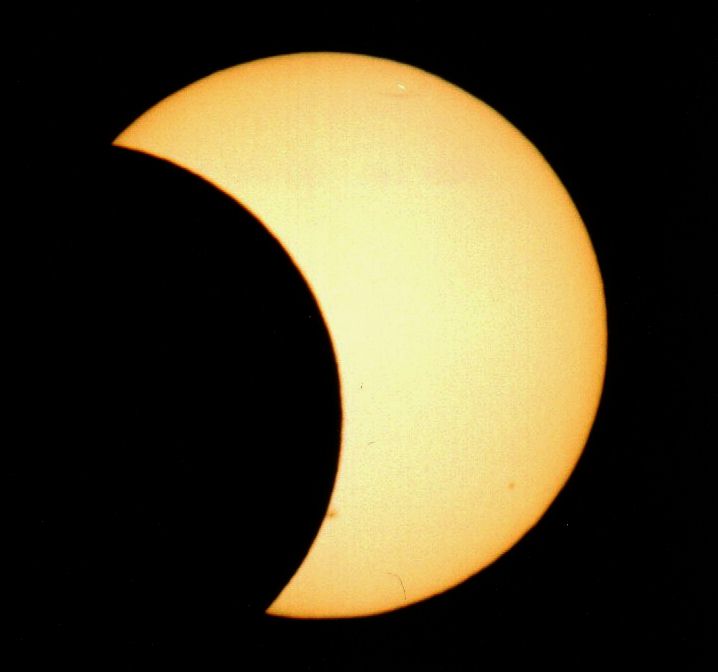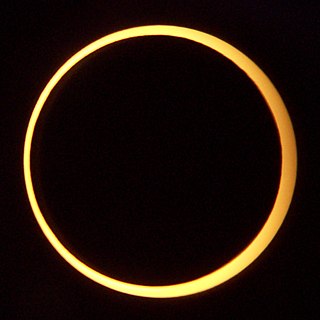First, however, an explanation for the mechanism of eclipses is in order. A eclipse occurs when the Sun, the Moon, and the Earth are in a straight line, so that the Moon casts a shadow on the Earth, or vice versa. When the Earth casts a shadow on the Moon, the eclipse is lunar. When the Moon casts a shadow on the Earth, the eclipse is solar. An illustration of both of these eclipse types is shown below (not to scale).
In a solar eclipse, only a very small portion of the Earth's surface receives the shadow of the Moon, and this shadow moves across the Earth's surface as the Moon moves along its orbit. Furthermore, from the viewpoint of the observer on Earth, a solar eclipse is total when one is within the shadow of the Moon, and partial when one is in the partial shadow of the Moon (see above figure). The dark gray area is the shadow of the Moon, where both sides of the Sun are invisible. Thus in a total solar eclipse, none of the Sun is visible.
 |
| Total Solar Eclipse |
The light gray area in the above diagram is the partial shadow, or penumbra. In this region, one side of the Sun is visible, but the other is blocked from view. In a partial solar eclipse, the Sun is never completely covered by the Moon, but the Moon rather skirts the Sun, covering only one of its edges.
 |
| Partial Solar Eclipse |
Note that, on the diagram, since the Sun is larger than the Moon, the rays of the Sun on either side of the Moon converge with distance, and the shadow of the Moon on the Earth is a great deal smaller than the Moon itself. In fact, since the distance between the Earth and the Moon varies, when the Moon is farthest from the Earth and an eclipse occurs, the shadow of the Moon no longer reaches the Earth. In other words, from the perspective of the Earth viewer, the size of the Moon's disc is smaller than the size of the Sun's disc, and the Moon cannot cover the Sun. This leads to a phenomenon known as a annular solar eclipse.
 |
| Annular Solar Eclipse |
Conversely, a lunar eclipse occurs when the Earth is between the Sun and the Moon. There are partial and total lunar eclipses as well, although the definitions differ slightly, as they are geocentric; in other words, the definitions are not based on an observer on the Moon, rather one on the Earth. Since the Earth's shadow is large, it can completely cover the Moon, as opposed to a solar eclipse, which is a localized event. A partial lunar eclipse is one in which the Earth's shadow does not completely cover the Moon, and a total lunar eclipse is one in which the Earth's shadow completely covers the Moon. During a total lunar eclipse, the Moon takes on a characteristic red color.
 |
| Total Lunar Eclipse |
The Moon appears red during a lunar eclipse due to the fact that the only light reaching the Moon passes through a good deal of the Earth's atmosphere. Most short wavelengths of light are scattered by the time the Sun's rays have passed all the way through, so only long-wavelength light remains, causing the Moon to appear red in the visible spectrum. The same effect makes sunrises and sunsets appear red.
Though these types of solar and lunar eclipses differ in appearance, they are all manifestations of the same phenomenon: the alignment of the Sun and the Moon with respect to the Earth. Looking only at the diagram of a solar eclipse, one would believe that such events would be quite common, and would occur every time the Moon orbits around the Earth to come in line with the Sun. This would be true if the orbits of the Sun and the Moon lay in the same plane. However, the plane of the Moon's orbit around the Earth is inclined relative to the plane of the Earth's orbit around the Sun, and to make matters worse, the orbit is constantly shifting.
The next post discusses how eclipses can be predicted by understanding the various cycles of the Moon, Earth, and Sun.
Sources: http://eclipse.gsfc.nasa.gov/eclipse.html, http://image.gsfc.nasa.gov/poetry/ask/a11846.html, http://kids.britannica.com/elementary/art-87433/During-a-solar-eclipse-the-Moon-passes-between-the-sun, http://indiancountrytodaymedianetwork.com/sites/default/files/uploads/2012/11/solar-eclipse.jpg, http://www.topnews.in/files/SolarEclipse.jpg, http://upload.wikimedia.org/wikipedia/commons/thumb/3/37/Annular_Eclipse._Taken_from_Middlegate,_Nevada_on_May_20,_2012.jpg/320px-Annular_Eclipse._Taken_from_Middlegate,_Nevada_on_May_20,_2012.jpg, http://en.wikipedia.org/wiki/Saros_(astronomy),

No comments:
Post a Comment